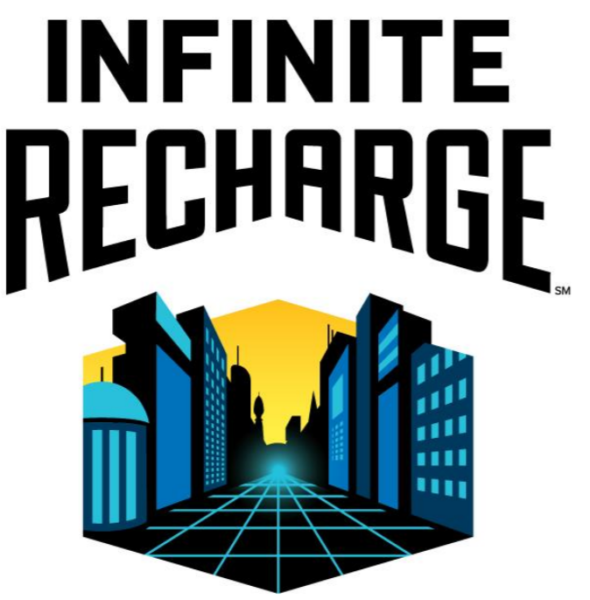2025 – REEFSCAPE
In REEFSCAPE℠ presented by Haas, two competing alliances are invited to score coral, harvest algae, and attach to the barge before time runs out. Alliances earn additional rewards for meeting specific scoring thresholds and for cooperating with their opponents.
FRC teams will use their engineering skills to strengthen one of the ocean's most diverse habitats – making waves to build a better world.
2024 – CRESCENDO
In CRESCENDO℠ presented by Haas, two competing alliances are invited to score notes, amplify their speaker, harmonize onstage, and take the spotlight before time runs out. Alliances earn additional rewards for meeting specific scoring thresholds and for cooperating with their opponents.
During the first 15 seconds of the match, robots are autonomous. Without guidance from their drivers, robots leave their starting zone, score notes in their speaker or amp, and collect and score additional notes.
During the remaining 2 minutes and 15 seconds, drivers control their robots. Robots collect notes from human players at their source and score them in their amp and speaker. Each time an alliance gets 2 notes in their amp, the human player can amplify their speaker for 10 seconds. Notes scored in an amplified speaker are worth more points than those scored in an unamplified speaker. A human player may choose to repurpose a note scored in their amp in cooperation with their opponent. If each alliance repurposes a note by hitting their Coopertition button in the first 45 seconds of teleop, all teams in the match receive a Coopertition point (which influences their rank in the tournament), and the number of notes needed for the melody bonus is reduced.
As time runs out, robots race to get onstage and deliver notes to their traps. Harmonizing robots, i.e. robots sharing a chain, earn an added bonus. Robots earn even more points if a human player spotlights robots on a chain by scoring a note on the chain's microphone.
The alliance that earns the most points wins the match!

2023 – CHARGED UP
In CHARGED UP℠ presented by Haas, two competing alliances are invited to process game pieces to bring energy to their community. Each alliance brings energy to their community by retrieving their game pieces from substations and scoring it into the grid. Human players provide the game pieces to the robots from the substations. In the final moments of each match, alliance robots race to dock or engage with their charge station!
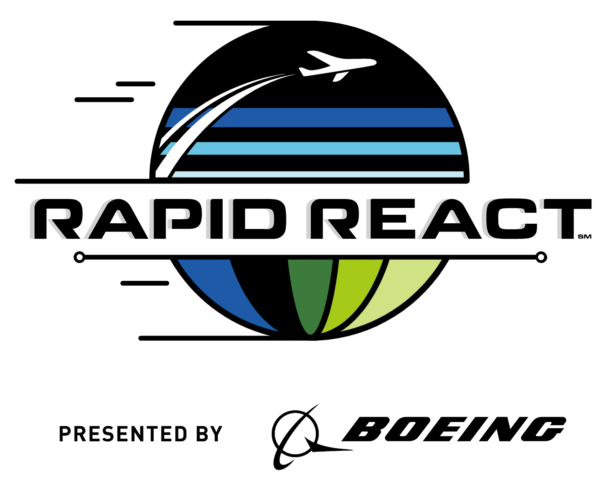
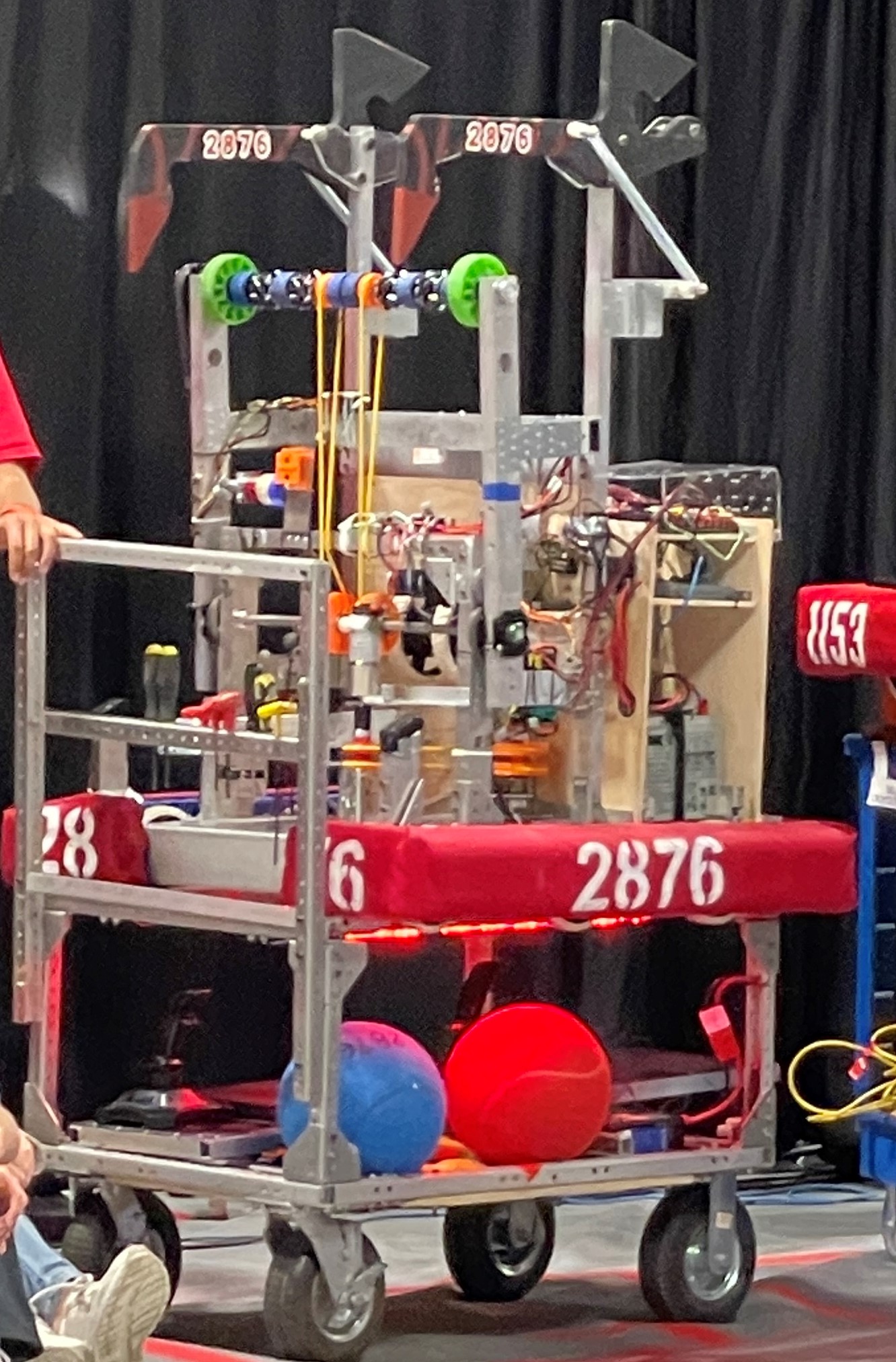
2022 – RAPID REACT
In RAPID REACTSM presented by The Boeing Company, two competing alliances are invited to process cargo for transportation. Each alliance is assigned a cargo color (red or blue, based on alliance affiliation) to process by retrieving their assigned cargo and scoring it into the hub. Human players assist the cargo retrieval and scoring efforts from within their terminals. In the final moments of each match, alliance robots race to engage with their hangar to prepare for transport!
Each match begins with a 15-second autonomous period, during which time alliance robots operate only on pre-programmed instructions to score points by:
- taxiing from their tarmac and
- retrieving and scoring their assigned cargo into the hub.
In the final 2 minutes and 15 seconds of the match, drivers take control of the robots and score points by:
- continuing to retrieve and score their assigned cargo into the hub and
- engaging with their hangar.
The alliance with the highest score at the end of the match wins!
2020 – INFINITE RECHARGE
In INFINITE RECHARGESM, two Alliances work to protect FIRST City from approaching asteroids caused by a distant space skirmish. Each Alliance, along with their trusty droids, race to collect and score Power Cells in order to energize their Shield Generator for maximum protection. To activate Stages of the Shield Generator, droids manipulate their Control Panels after scoring a specific number of Power Cells. Near the end of the match, droids race to their Rendezvous Point to get their Shield Generator operational in order to protect the city!
In 2020, our robot was just completed when all public activities were curtailed. The entire FRC competition schedule (with the exception of Week One events for which we were not registered) was cancelled. Our robot waited patiently for the next year and a half until the long-running off-season event "River Rage" was held on October 30, 2021. A portion of the team attended and the new student members learned what an FRC competition is all about. They competed in qualifications and were chosen for the second-seed alliance, eventually taking second place with their alliance partners. The robot picked up "power cells" and put them in the delivery port, defended against opposing alliance members, and got valuable practice in playing field strategies and alliance decision-making.
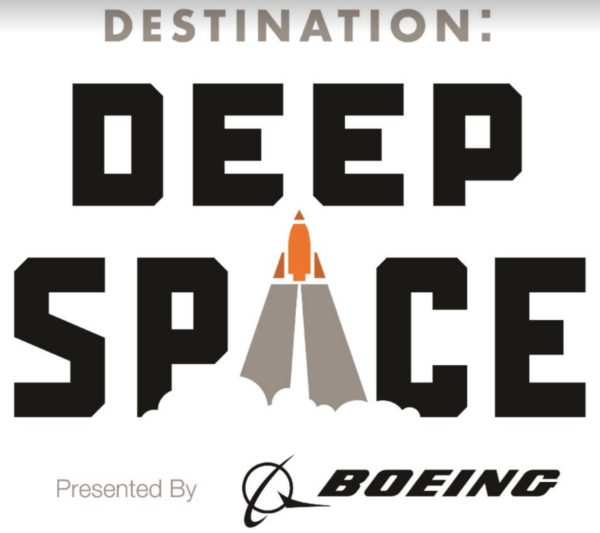
2019 – DESTINATION DEEP SPACE
In DESTINATION: DEEP SPACE, Presented By The Boeing Company, we join two competing Alliances collecting samples on Planet Primus. Unpredictable terrain and weather patterns make remote robot operation essential to their mission on the planet. With only 2:30 until liftoff, the Alliances must gather as many cargo pods as possible and prepare their spaceships before the next sandstorm arrives.
When the sandstorm clears, human operators take control of their robots. Alliances continue to score points by:
- Preparing rockets and cargo ship with hatch panels
- Loading more cargo pods
- Returning the robot safely to the Alliance's Hab

2018 – POWER UP
FIRST® POWER UPSM, the 2018 FIRST® Robotics Competition game, includes two alliances of video game characters and their human operators who are trapped in an arcade game. Both alliances are working to defeat the boss in order to escape!
Each three-team alliance prepares to defeat the boss in three ways:
- Control the Switches and the Scale. Robots collect Power Cubes and place them on Plates to control Switches or the Scale. When the Scale or their Switch is tipped in their favor, it is considered owned by that Alliance. Alliances work to have Ownership for as much time as possible.
-
Earn Power Ups. Robots deliver Power Cubes to their humans who then place them into the Vault earning the Alliance Power Ups. Alliances use Power Ups to gain a temporary advantage during the Match. There are three Power Ups available to teams: Force, Boost, and Levitate.
- Force gives the alliance ownership of the Switch, Scale, or both for a limited period of time
- Boost doubles the rate points are earned for a limited period of time
- Levitate gives a robot a free climb
- Climb the Scale. Robots Climb the Scale in order to be ready to Face The Boss.


Our Steamworks Robot
2017 – STEAMWORKS!
Steamworks is a steampunk-themed competition that challenges two Alliances of three teams to prepare their airship for takeoff. Teams do this by shooting fuel into their boilers, securing gears, and climbing a rope to the top of their airship to earn points for their Alliances.
The gears worked out to be the most critical factor in game play, and our robot handled them well. Once delivered by the robot, a human player had the job of raising the gears and placing them on a cog to allow them to turn a rotor. In the last 30 seconds of the match, the human players drop the team's ropes and the robots climb to reach a pressure pad that they must trigger to score a large number of points. While we had some trouble delivering results at our initial competition at Windham, NH, we were able to make significant changes that allowed us to preform extremely well at our second competition. We delivered gears quickly and consistently managed to climb for the bonus points.
Sadly though, it wasn't enough to offset our low standing in the first competition, and we did not qualify for further competitions, leaving the team with a longing for victory. However, our determination and our Steamworks robot were showcased the following October at the 21st annual River Rage off-season competition, where, with our Alliance partners, we took first place. Our determination has not wavered and we look forward to next year's competitions.

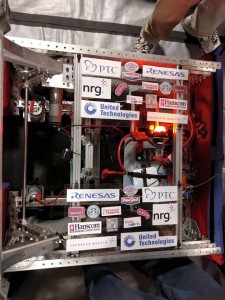
2016 – STRONGHOLD
Stronghold is a medieval themed competition. Two alliances comprised of three teams, each compete against one another to break down their opponent's defenses and capture the opposing alliance's tower. Points can be earned by passing or "breaking down" the opponent's defenses and then capturing their tower. Each defense can be crossed up to three times. FIRST has also implemented a new rule. Four out of the five defenses on the field can be moved. One of the defenses are chosen and placed through audience selection. The remaining three defenses are chosen by the teams themselves.
The tower can be captured by using "boulders", which can be shot into the high and/or low goals to score points. To completely take over the tower, eight boulders have to be shot into the tower's goals. Robots have the opportunity to earn more points in the final fifteen seconds of the match by having robots drive up to the tower. The tower is fully captured when all three robots of the alliance drives up to the tower.
Additionally, points can be earned if the robots scales the tower in the final seconds.
Stronghold was the team's most challenging competition to date. At our District competitions in Reading, MA, and UNH in Durham, MA, we competed very well, and finished our Qualification matches high enough to be one of the eight team captains both times, going into the Finals. At UNH we won a Pit Safety Award and the official Team Spirit Award, and our new Pit design was admired by all. We qualified for District Championships and competed in Hartford, CT.
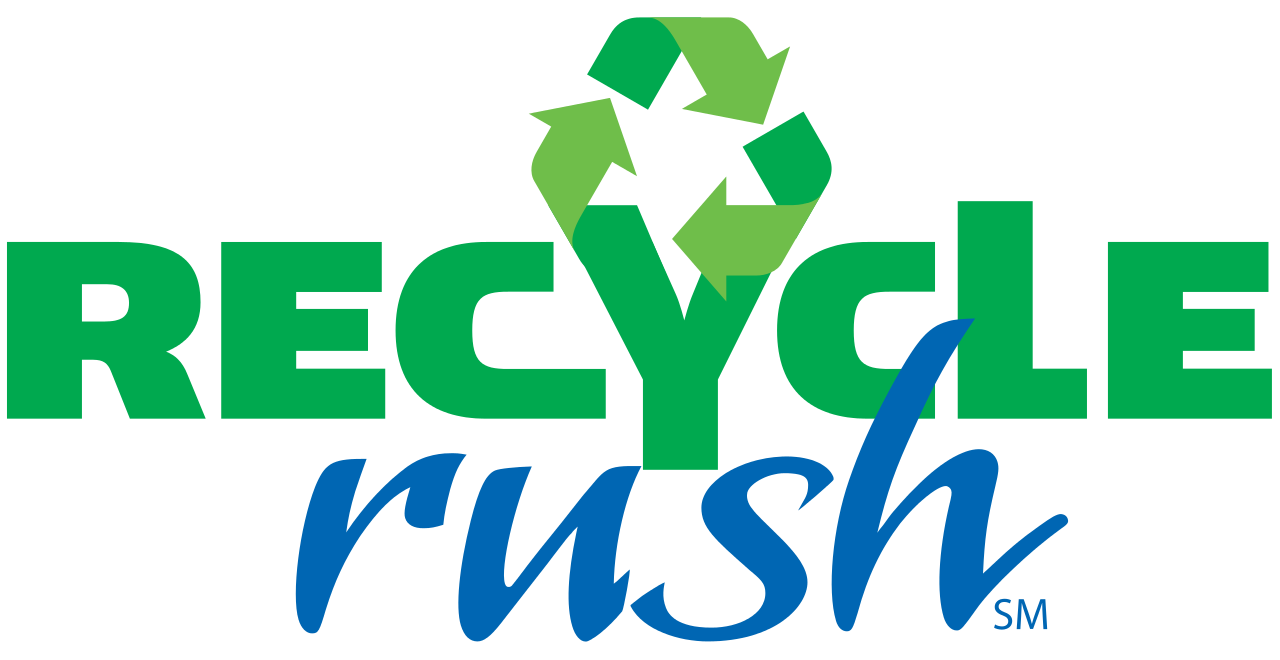
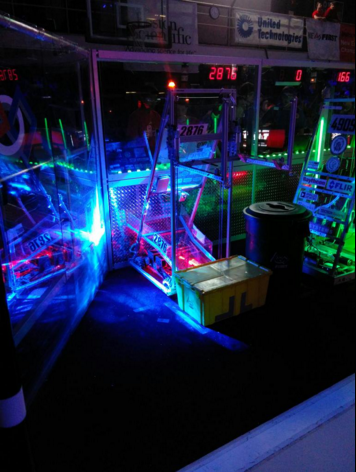
2015 – Recycle Rush
Recycle Rush is a game that integrated environmental concerns into FRC. The game consisted of two opposing alliances, both with three robots each, that tried to stack up to six recycling totes on top of one another on raised platforms. To raise the amount of points received, the totes could be topped with a recycling container. Teams also had the opportunity to higher their score by inserting "litter", or pool noodles, into the containers. These pool noodles could also be thrown by the human player into their team's Landfill zone. The match incorporated a new aspect of FIRST known as Coopertition®! Teams were given three yellow totes in addition to their grey totes. The two competing alliances had the opportunity to win an additional forty points each by creating a stack of four totes between their playing field using these yellow totes. This year's game was also different from previous games because of the separate fields. Teams had to remain on their side for the entirety of the match resulting in robots that were more game oriented.
The DevilBotz did exceptionally this season! Their performance during the district championships held in Reading and Nashua caused them to advance to the regional championships held at Worcester Polytechnic Institute. Our robot's ability to stack both containers and totes at a fast pace enabled our team to participate at the FRC World Championships for the first time in our team's history! This experience, as well as the challenge as a whole, was exceedingly fun!
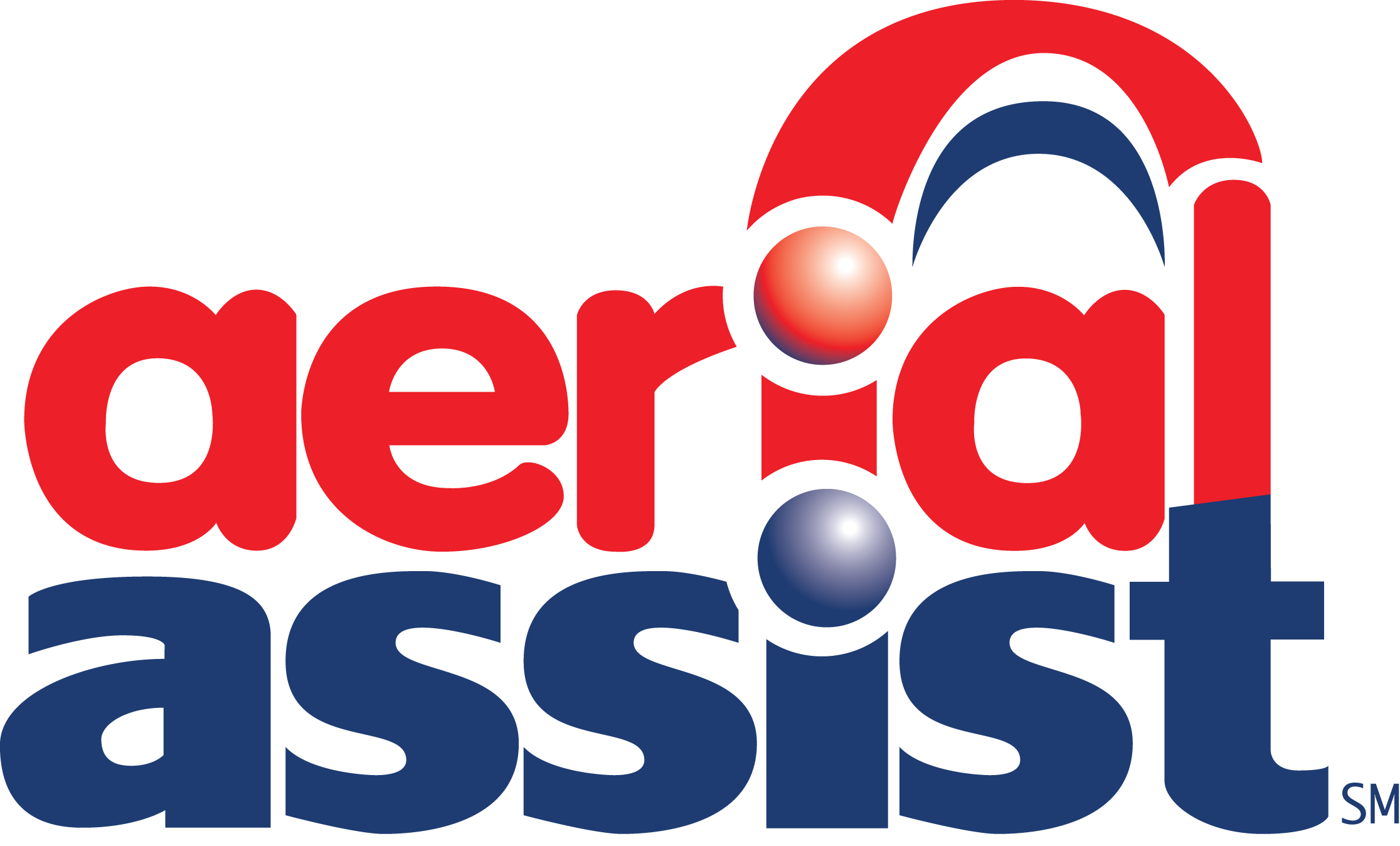
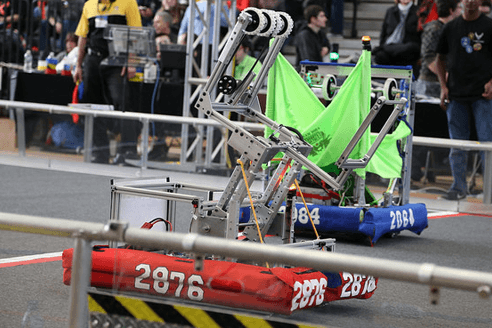
2014 – Aerial Assist
Aerial Assist is also played by two competing Alliances of three robots on a flat field. The field, however, is straddled by a truss suspended just over five feet above the floor. The objective is to score as many balls in the goal as possible during a 2 minute and 30 seconds. The more the Alliances work together and score the ball in their goals, the more points their Alliance receives. Aerial Assist demonstrated what our team was truly capable of. In both competitions we entered, the DevilBotz were chosen to enter the finals. Our robot performed consistently, and it did the job we made it to do flawlessly. This challenge was centered around teamwork, as the more a team passed to their alliances members, in different zones, the more points the alliance received once they shot the ball into either a 1 point or a 10 point goal. Our robot could shoot in the 1 point goal only, so the team's strategies with our alliances partners allowed us to soar. It was an extraordinary year for the team!

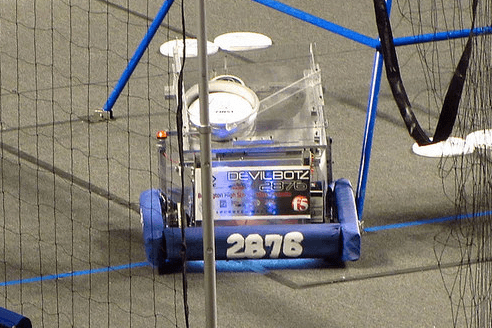
2013 – Ultimate Ascent
Ultimate Ascent is played by two competing alliances on a flat, 27 x 54 foot field. Each Alliance consists of three robots, and they compete to score as many discs into their goals as they can during a 2 minute and 15 second match. The higher the goal in which the disc is scored, the more points the Alliance receives. The match begins with a 15 second Autonomous Period in which robots operate independently of driver inputs. Discs scored during this period are also worth additional points. In this competition, the match ends with robots attempting to climb up pyramids located near the middle of the field. Each robot earns points based on how high it climbs. Ultimate Ascent was a huge success for the DevilBotz! During this challenge, the team was chosen to perform in the finals. We created an amazing scouting process that put us in many teams' good graces and greatly assisted our drivers. The challenge was shooting Frisbees into slots above the player stations. In the final seconds, teams had the option to climb their alliance's pyramids and dump Frisbees onto the top of the structure. This is our smallest robot to date, which was an advantage in navigating the field during this year. Our robot's simplicity lead to our success, and our involvement in the finals made other teams aware of our presence on the field.
Our frisbee-throwing robot has been a crowd favorite at Burlington's Independence Day Parades for many years.
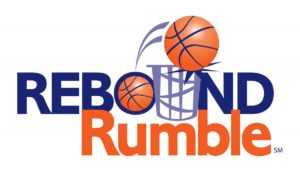
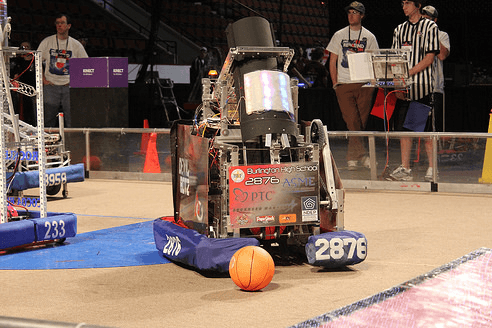
2012 – Rebound Rumble
Rebound Rumble is played by two competing Alliances on a flat field. Each Alliance consists of three robots, which compete to score as many basketballs into their hoops as they can during a 2 minute and 15 second match. The higher the hoop is on the field, the more points the Alliance will receive when they score in that particular hoop. Rebound Rumble was our team's first experience in the finals! Our robot rose through ranks and earned a position as a default robot in the finals. Unfortunately for one of the alliances, one of their fellow robots broke down, and they needed us to step in. While we empathized with the robot that broke, we were ecstatic to get the chance to aid our alliance in their final matches. This challenge consisted of shooting basketballs into hoops that differed in height. As the end of the match neared, different alliances worked together to balance their robots on a teetering bridge. The exposure to the finals drove our team to aim higher and lead to success in our future.


2011 – Logomotion
Logomotion is played by two competing alliances on a flat 27' x 54' field. Each alliance consists of three robots, which compete to hang as many inflated plastic shapes (triangles, circles, and squares) on their grids as they can during a 2 minute and 15 second match. The higher the teams hang their game pieces on their scoring grid, the more points their alliance receives. The match begins with one 15-second Autonomous Period in which robots operate independently of driver inputs and must hang Ubertubes to score extra points. For the rest of the match, drivers control robots and try to maximize their alliance score by hanging as many logo pieces as possible. Any logo piece hung on the same peg as an Ubertube receives double points.
Logomotion was FIRST's 20th FRC challenge. The game pieces were the FIRST logo in honor of the event, and the robot had to place them on pegs that earned your team more points the higher the peg that the inflatable game piece was placed on. In the final seconds of the round, the robots had the option to deploy an FTC mini-bot that climbed up a pole for many extra points. This was the first year our team decided to use pneumatics. We also had an impressive electrical board. We found that executing a robot that has the ability to complete every task was an enormous challenge, and it was an eye-opening experience, one that would guide the team for years to come.

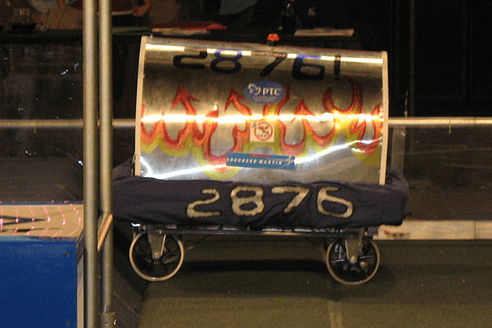
2010 – Breakaway
Two alliances of three teams each compete on a 27ft x 54ft field with bumps attempting to earn points by collecting soccer balls in their goals. Additional bonus points are earned for each robot not touching the field at the end of the match. Robots may not possess more than one ball at a time, but they may herd and kick multiple balls at a time. Balls must remain in contact with the floor while in robot's possession. Also only one robot at a time is permitted to play defense in front of the opponent's goals.
Breakaway has a special place in our hearts because many remember the "Devil's Barbecue," the name the announcer gave to our robot during this competition. This was the year we won the Jack Kamen imagery award, due to our striking robot, carefully painted shipping crate, and matching t-shirts.
The challenge was basically robot soccer. The interesting part was the bonus challenge, where robots had to suspend themselves from the ball return rack. It was amazing to see what the teams came up with, and it was an experience the DevilBotz will never forget!

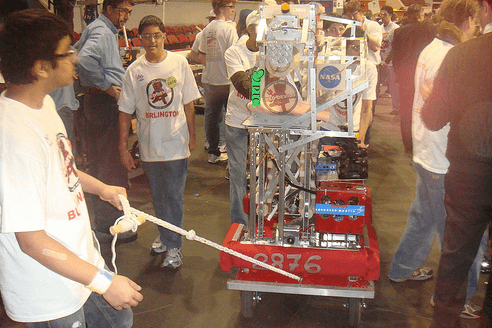
2009 – Lunacy
Announced on January 3, 2009, the name and some of the features of the game honor the 40th anniversary of the first manned mission to the Moon. This is the first FRC competition to use the crio Mobile Device Controller control system from National Instruments. Lunacy is played on a rectangular field that is 54ft by 27ft. There are 6 robots on the field at a time, 3 on the red alliance and 3 on the blue alliance. Each team consists of four players: two drivers, a coach and a human player. Robots have to fit within a 38in by 28in footprint, be less than or equal to 60in tall, and weigh under or equal to 120 pounds. The goal of the game is to score as many of the game pieces in the opposing side's trailers as possible. Robots start out in front of the opposite alliances' human players.
- Moon Rocks (Orange and Purple) — 120 available — 2 pts each
- Empty Cells (Orange and Blue) — Up to 8 — 2 pts each
- Super Cells (Green and Purple) — Up to 8 — 15 pts each
Lunacy was our team's rookie year, as demonstrated by our white shirts. Posed with an interesting challenge our first year, the surface was a low friction laminate designed to simulate the lunar surface. The robot had to drag a trailer while depositing "moon rocks" in the opposing alliances trailers. We learned a lot our rookie year, and it was a solid starting point for our future in FIRST!
</div>
